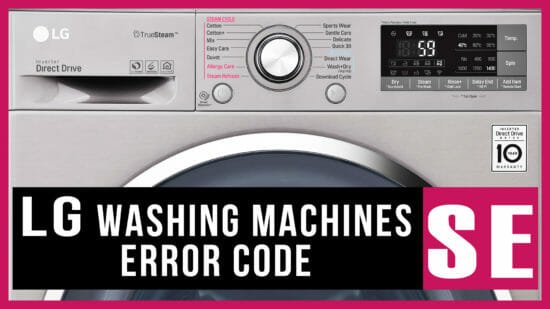
Error codes are your machine’s way of telling you something is off, just like a warning light on your car dashboard. The “SE” error code on an LG washing machine is a signal that the machine is having trouble spinning. It often boils down to an issue with the motor sensor, or sometimes, it’s due to more common causes like a tangled load of laundry or a clogged drain. Ignoring it might lead to further complications down the road, which is why it’s crucial to understand what’s really happening here.
What Causes the SE Error Code?
To truly appreciate the complexity of why this error pops up, let’s dive into the possible causes. You see, the “SE” error primarily revolves around the machine’s motor sensor. This sensor plays a vital role much like your thermostat at home — it carefully monitors the temperature and conditions to ensure everything is running smoothly.
Sometimes, however, the problem isn’t as intricate as it seems. Your machine might be struggling to spin due to an overloaded wash. Think about what happens if you try to carry too many grocery bags at once. Your arms twist awkwardly, and you might end up dropping something. Similarly, an overloaded washing drum makes it tough for the machine to complete its spin cycle, triggering the SE error.
Another common culprit is a clogged drain filter. Over time, bits of fabric, lint, or even small items like coins can sneak past the drum and clog the filter. Imagine trying to drink a thick milkshake through a straw — that’s your washing machine attempting to drain with a blocked filter. It’s frustrating and could lead to potential overflow if neglected.
Why Ignoring the Error Isn’t the Best Idea
Here’s the deal: ignoring an error code on your washing machine is akin to ignoring a nagging toothache. Sure, it might seem manageable at first, but over time, it could spiral into a bigger problem. If the root cause of the SE code is a motor issue, continuous usage without addressing it could lead to a complete motor malfunction. Replacing a motor is both time-consuming and costly — not to mention it could leave you without a washer on laundry day.
Even if the underlying issue is due to something simpler, like a laundry imbalance, bypassing it could still have repercussions. An imbalanced drum will rock back and forth excessively, potentially causing physical damage to the machine itself. Extended periods of irregular use can also affect other components, leading to a symphony of other error codes, which just means more headaches.
So, the best bet? Address the issue sooner rather than later. It’s much like dealing with that squeaky door hinge at home — a little effort up front can save you from annoying creaks (or in the washing machine’s case, bigger breakdowns) in the long run.
Steps to Resolve the SE Error Code
Now, if you’re staring at that blinking SE code, fret not. Here’s a simple plan to tackle the issue head-on, just like a DIY enthusiast. First, ensure your load is evenly distributed. If your machine is struggling with a group of heavy items like towels or jeans, try redistributing them to balance the weight.
Next, inspect the drain filter. This might seem daunting, but it’s straightforward: locate the filter at the bottom front of your machine, gently unscrew it, and clear out any debris. This step is like unclogging a sink — a bit messy, but highly satisfying once you see the blockage disappear.
If those steps don’t clear the code, you might need to consider the motor sensor. While this might require a bit more technical know-how, consulting your manufacturer’s manual or reaching out to a professional can set you on the right path. Think of it as calling in a skilled friend when a home repair extends beyond your expertise.
Preventing Future SE Errors
So, you’ve shaken off the SE code this time, but how do you keep it at bay? Like regular dental check-ups, maintaining your washing machine can prevent future hiccups. Consider emptying pockets before washes to avoid small items clogging the system. Regularly check and clean the drain filter — a task as routine as taking out the garbage.
Also, avoid overloading your machine. Wash heavier items separately to lighten the load, much like splitting groceries into multiple trips if they’re too heavy in one go. And finally, don’t hesitate to run a maintenance cycle with vinegar or a specialized cleaner to keep the drum fresh and free of residue.
In short, giving your washing machine a little TLC can ensure that the SE code becomes a distant memory, not a recurring nightmare. Remember, being proactive with appliance maintenance is always easier than tackling major repairs. By following these steps, you can keep your LG washing machine running smoothly and error-free.